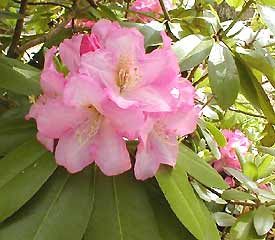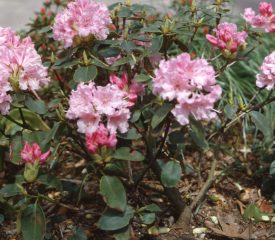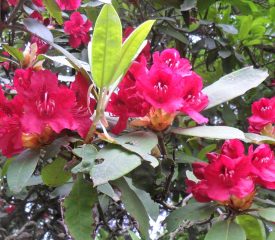


Dorothy Knippenberg began hybridizing rhododendrons in 1955 at Laurelwood Gardens, and she continued to strive for plants with new interests and improvements, such as hardy large-leaf plants, more flower substance, and later-blooming periods.
Together with her husband, John, they operated two nurseries: one at Laurelwood Gardens and a second one on the Virginia eastern shore. They maintained a test garden at their Wayne nursery and subjected many west coast plants to the New Jersey climate. They cultivated more than fifty new named rhododendron hybrids. Hundreds of rhododendrons raised at Laurelwood
Gardens were recognized with awards at annual flowers shows. The Knippenbergs had eight cultivars of rhododendron registered with the American Rhododendron Society and the Royal Horticultural Society in England, which is the International Cultivar Registration Authority (ICRA) for the genus Rhododendron. The naming of cultivated plants, including rhododendrons, must be accepted by the ICRA.
Several of the rhododendrons hybridized and registered or named by the Knippenbergs are highlighted below.
One of Dorothy’s earliest hybrids was probably ‘Caroline Gem,’ which she hybridized in 1955 using Joseph Gable’s ‘Caroline’ as seed parent crossed with the vivid red of the hybrid ‘Elizabeth’. The result produced ‘Caroline Gem’ with its rose-red shade of color about halfway between the lavender flowers of ‘Caroline’ and the vivid scarlet red of ‘Elizabeth.’ The new hybrid was raised and named by Dorothy and introduced commercially at Laurelwood Gardens. She registered it in 1967. Although no longer found in the arboretum, its parent ‘Caroline’ can be seen on Ridge Road in the Gable Garden.
Another of Dorothy’s earliest hybridization successes was the elepidote rhododendron ‘Big Mac’ which she hybridized in 1955, grown it to its first flower, named and introduced it commercially at Laurelwood Gardens. It was registered by her in 1977. The hybrid rhododendron contained pale-greenish yellow flowers with a dark red blotch, and it grew in Laurelwood Arboretum until it was crushed by a fallen tree during a storm.
Another elepidote rhododendron ‘Laurel Pink’ was highlighted by Dorothy during a virtual tour of Laurelwood Gardens in 1964 which Dorothy conducted for the New York Chapter of the American Rhododendron Society. She noted its hardy nature and its lacelike delicacy with twelve florets per truss forming neat pink balls. It was raised, named by Dorothy, and introduced commercially at Laurelwood Gardens prior to 1966. It was registered by her in 1966. ‘Laurel Pink’ was available for sale at one time at Baldseifen Nursey which was in Rochelle Park before moving to Paramus and finally settling in Bellvale, New York. Although no longer growing in the arboretum, we have the benefits of a photo of ‘Laurel Pink’ which was growing at the former Knippenberg home on Pines Lake Drive West.
One of Dorothy’s favorite rhododendrons was the elepidote hybrid ‘Blush Button’. Noted for its “button” where the stamens should be, its flowers are shaded coral red in bud, creamy brush color. It was named by her and introduced commercially at Laurelwood Gardens. It was registered by her in 1966. It no longer grows in the arboretum.
‘Powder Puff’ is a tree-like rhododendron that displays flowers starting out lavender pink in bud, opening nearly white. Created by pioneer hybridizer Charles O. Dexter pre-1943 at his estate in Sandwich, Massachusetts, it was named by Dorothy Knippenberg in 1978 and introduced commercially at Laurelwood Gardens the same year. It is still growing on Long Valley Road in the arboretum.
The elepidote rhododendron ‘Burgundy Cherry’ was hybridized by American pioneer hybridizer Charles O. Dexter at his estate in Sandwich, Massachusetts (pre-1943). It was named and introduced commercially at Laurelwood Gardens by Dorothy Knippenberg in 1974. She registered it in 1980. The flower color is carmine with doge purple at the base of its throat and in a dorsal blotch. It no longer exists in the arboretum.
In 1953, an entire hillside in Laurelwood Gardens was planted with 6,000 Dexter seedlings from renowned American hybridizer Charles O. Dexter of Sandwich, Massachusetts. From these, one excellent late blooming form was selected and was named ‘Wayne Pink’ by John Knippenberg.
The elepidote rhododendron was raised and introduced commercially at Laurelwood Gardens by John who also registered it in 1966. Its domed-shaped truss contained 19 to 22 spirea red flowers. Although a very hardy plant, it no longer grows in the arboretum.
The elepidote rhododendron ‘Hardy Giant’ was hybridized by Donald L. Hardgrove of Merrick, Long Island who gave four plants to New Jersey hybridizer Guy Nearing, and Mr. Nearing gave one of the plants to Dorothy Knippenberg. Dorothy raised ‘Hardy Giant’ and introduced it commercially at Laurelwood Gardens, and she is credited with naming it. She registered the rhododendron in 1966. Its flowers were creamy white with a raspberry blotch. Its conical truss contained 14 flowers and leaves are from 12-inches to 15-inches long. Noted for its hardiness, hence the name, Dorothy remarked that the temperature dropped to sixteen below zero one winter and the plant never showed any winter injury. Despite its hardiness, it is no longer growing in the arboretum.
The elepidote rhododendron ‘Big Willy’ was raised by Dorothy Knippenberg (pre-1985). She named and introduced it commercially at Laurelwood Gardens. Its small white flowers bloomed in early spring. Its parentage was ‘La Bar’s White’ and the species williamsianum whose pale pink flowers often fade to white. Although no longer found in the arboretum, its parent williamsianum can be seen in front of the Knippenberg Center for Education and ‘La Bar’s White’ can be seen in several locations in the arboretum.
The final Knippenberg registered rhododendron is a lepidote rhododendron, ’Laurelwood Snow Bunting’ which was hybridized by Dorothy in 1960, grown to its first flower, named, and registered by her in 1988. It is not known if it was ever offered for sale commercially. Her selection of a pink mucronulatum species for the cross probably helps to explain the inclusion of the word “snow” in its name since mucronulatum rhododendrons are very early bloomers often while there is still snow on the ground. Its rose color in bud faded to white after opening. Sadly, Laurelwood Snow Bunting’ no longer grows in the arboretum, and there are no known photographs of ‘Laurelwood Snow Bunting’ available.
Dorothy Knippenberg is credited with naming the Ironclad elepidote ‘Great Eastern’ known as Dexter #109 prior to its naming by Dorothy, which was hybridized by Charles O. Dexter, America’s pioneer hybridizer of Sandwich, Massachusetts, (pre-1943). Dexter often numbered rather than named his hybrids. Our records show that Dexter #109 was growing in the arboretum as early as 1964. It was registered by Scott Arboretum of Swarthmore College in Pennsylvania in 1983. Ironclad refers to a rhododendron with the ability to withstand severe winter conditions. Its flowers are deep purplish pink, paling to light pink. Although the original plant no longer grows in the arboretum, we obtained a young ‘Great Eastern’ rhododendron raised by the horticultural program at Mercer County Community College which is growing at the rear of the Sensory Garden in the arboretum.
The elepidote rhododendron ‘Dexter’s Red Velvet’ was hybridized (pre-1943) by Chares O. Dexter at his estate in Sandwich, Massachusetts. It was named by Dorothy Knippenberg and introduced commercially at Laurelwood Gardens (pre-1972). It was registered by the Princeton Chapter Study Group in 1997. Its bright crimson red flowers contained a dark greyish purple spotted flare from its throat to near the margin of its dorsal lobe. It no longer grows in the arboretum.
The elepidote rhododendron ‘Paul Vossberg’ was named by Dorothy Knippenberg in honor of Paul Vossberg, who perfected a method of successfully rooting cuttings of rhododendron varieties previously difficult or impossible to root. He joined the Westbury Rose Company in 1943 and was a member of the original Dexter Study Committee. He visited Laurelwood Gardens at least once a year, and he became close friends with John and Dorothy Knippenberg.
In 1965, he gave Dorothy a small 15-inch unnamed rhododendron hybrid to propagate. She grew the plant to its first flower, named it, and introduced it commercially at Laurelwood Gardens in 1975. She registered it in 1994. Its flowers are a strong red with a dark red blotch on the dorsal lobe. The original ‘Paul Vossberg’ rhododendron still grows on Ridge Road in the arboretum. A second one is located at the south end of Dorothy’s Way. Our own Rhododendron Study Team has taken stem cuttings from the two plants to propagate, and several young ‘Paul Vossberg’ rhododendrons have been planted in the arboretum.
In 1976, her Azaleodendron, ‘Carolina Rose’ was awarded First Place at the National Flower Show of the American Rhododendron Society in Valley Forge, Pennsylvania. Azaleodendrons are crosses between elepidote rhododendrons and deciduous azaleas. Hybridized by Donald L. Hardgrove (pre-1946) of Merrick, Long Island, Dorothy named and introduced it commercially at Laurelwood Gardens. The rhododendron still grows on Dorothy’s Way in the arboretum.
Several of Dorothy’s other named hybrids were recognized at the American Rhododendron Society Princetown Chapter flower shows including ‘Blush Button’ Second Place (1969), ‘Topaz’ Second Place (1969, ‘Big Mac’ First Place (1970, ‘Red Velvet’ First Place (1973) and ‘Ivory Cloud’ First Place (19760.
In 1973, Dorothy Knippenberg was presented the Bronze Medal Award by the New York Chapter of the American Rhododendron Society in appreciation for her devotion to the genus Rhododendron.
Click here to see the Knippenberg Rhododendron Legacy Brochure.
